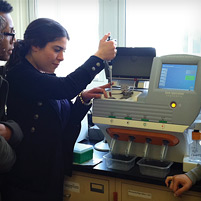Unique Access

First-year science students at Carnegie Mellon University can get a lab experience that goes beyond your basic beakers and petri dishes.
Reading the instructions encoded within our DNA holds the promise of a better understanding of health, disease and life itself, and presents one of the newest and most exciting challenges for career biologists.
CMU's Department of Biological Sciences is preparing students to meet this challenge.
As part of the Howard Hughes Medical Institute-funded Phage Genomics Research course, first-year students are getting hands-on experience in reading the genomes of viruses that infect bacteria, known as bacteriophages (phages for short), using one of the newest and most promising technologies available.
Last year's class was the first to use Life Technologies' Ion Personal Genome Machine (PGM). The PGM uses the semiconductor-based Ion Torrent DNA sequencing technology invented by CMU alumnus and entrepreneur Jonathan Rothberg (E'85).
"Our goal is to get students doing science as early as possible and to expose them to the latest ideas, latest research and latest technologies," said Nathan Urban, Frederick A. Schwertz Distinguished Professor of Life Sciences and Head of CMU's Department of Biological Sciences.
"The use of Ion Torrent in the Phage Genomics course is a great example of the kind of excitement that can be generated when these all come together. I predict that giving first-year undergraduates this kind of experience will be a transformative event in their college career."
While the first students to use the PGM are just beginning their sophomore years, they think Urban's prediction rings true.
"It was awe-inspiring to use such new technology, especially since we were first-years," said computational biology major Rene Francolini (S '15).
"This is something you could only get at Carnegie Mellon, and that's what makes this school so unique," she said.
Chemistry and physics major Lauren O'Neil (S '15) added, "It was a great opportunity to be able to do real research in the lab."
"I realized that cutting-edge research isn't miles beyond my dreams. I thought if I could do this as a first-year, everything else seems possible."
The Ion Torrent chip also is used in Life Technologies' Ion Proton Sequencer, which has been heralded for its ability to sequence the 3 billion base pairs in a person's DNA in one day for $1,000.
In the Phage Genomics Research course, taught by Associate Professors of Biological Sciences Javier Lopez and Jonathan Jarvik, and Assistant Teaching Professor Maggie Braun, the students isolate a bacteriophage from soil samples taken from around the country.
They then characterize their phage's structure using electron microscopy and clone its DNA. The DNA is incorporated into tiny microscopic beads that are loaded on to the Ion Torrent semiconductor chip. As the DNA sequence is copied, the PGM identifies each base pair in the sequence by detecting a subtle change in pH. The data are fed into a computer and assembled into a sequenced genome that the students can read.
They compare the genomes of their phages with previously cataloged phages to look for differences that may play a role in their phage's function.
Lopez noted that with the PGM they had fantastic results — each of the 16 students were able to sequence, assemble and annotate a genome of their own phage.
Before the PGM, the class could select only one phage to sequence, and the sequencing would be done by an off-site service.
But even with these limitations the students were able make important discoveries about how phages behaved and evolved — some of their findings have been published in journals and presented at scientific meetings.
"Now that we can read the genomes of more phages, we expect to find many more interesting and unexpected things," said Lopez.
Related Links: Next Generation Medical Imaging Workshop | Dept of Biological Sciences | The Lane Center for Computational Biology | Doctor in a Box
